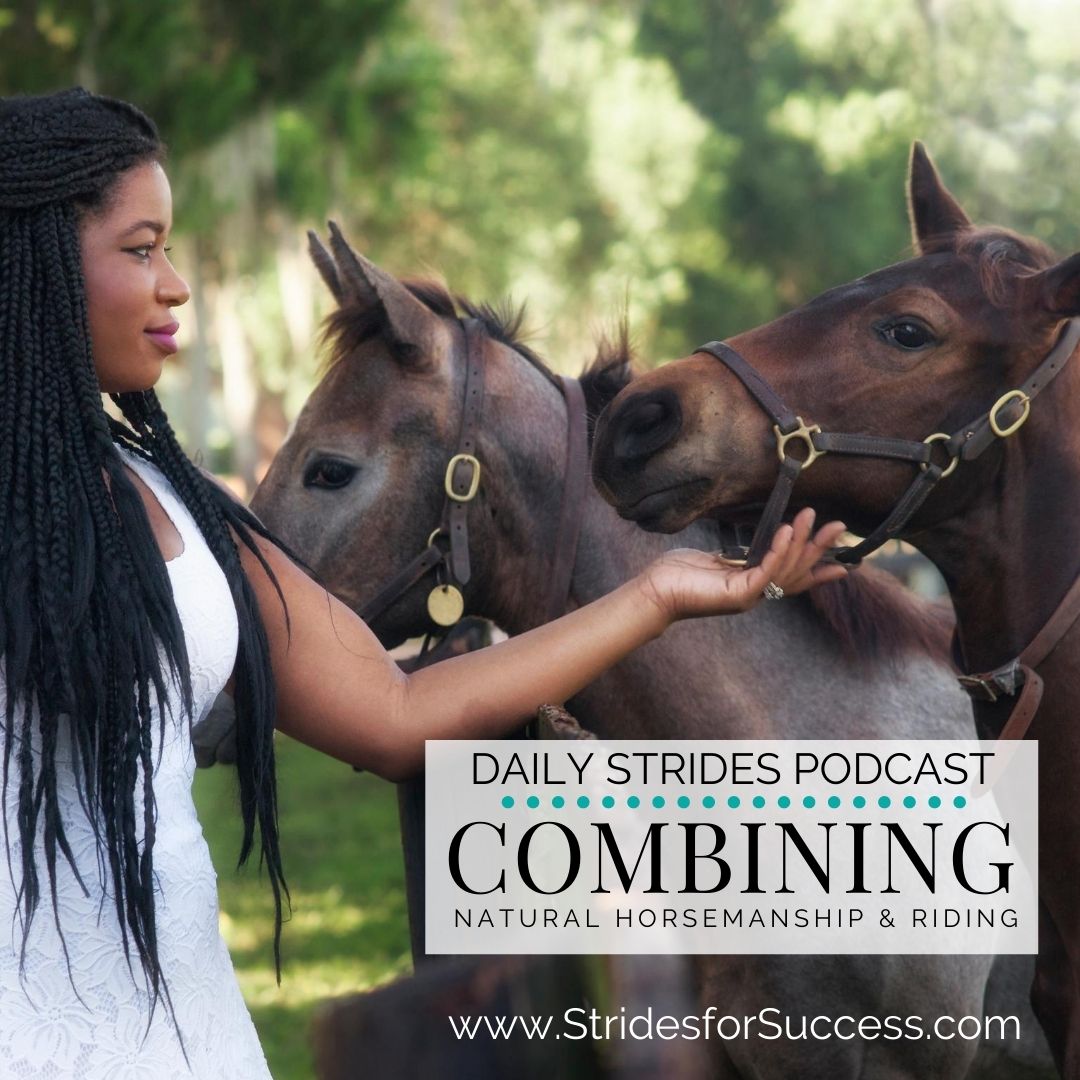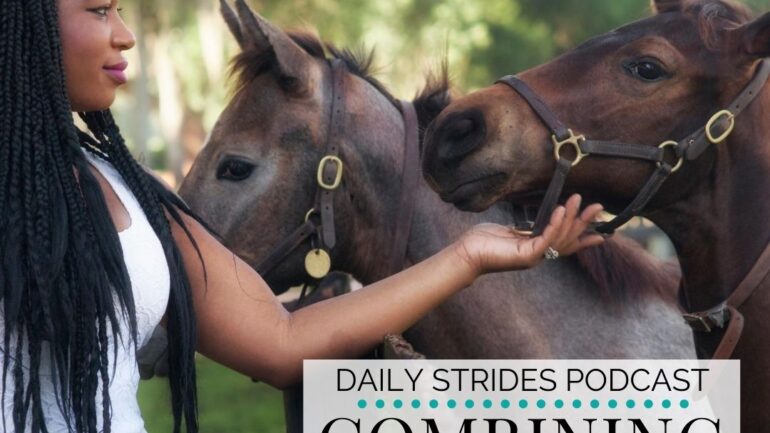Have you ever tried natural horsemanship? The name is a bit of a misnomer; is anything natural about horses and humans interacting and becoming partners? It’s debatable. However, misleading name aside, natural horsemanship can really help to build your partnership with your horse.
If – and this is a REALLY giant-sized if – it is done correctly and complements what you are trying to achieve in the saddle.

I personally use natural horsemanship in some shape way or form each and every day when interacting with horses. I can almost bet you are too. This is partly due to there being a fairly large shared area that almost all disciplines and methods of working with horses occupy. Horses are horses after all.
However, I also use specific methods on an almost daily basis which have their roots in natural horsemanship.
Is Natural Horsemanship the Same as Groundwork?
I think natural horsemanship is a form of groundwork. However, when I speak about groundwork and in my Groundwork for Riding program, I am more focused on the groundwork that will move the conversation forward when you do mount up. Groundwork that will later help improve your aids when you are riding.
I feel that natural horsemanship is more useful when building the actual partnership between horse and rider. The trust and the overall relationship. Strengthening the bond.
Will this in turn lead to better rides? Maybe. However, I have seen many examples where it has not. I think using natural horsemanship with the sole focus to improve your riding is not going to get you the results you are after. There are many more effective ways of improving your riding from the ground, such as lunging and groundwork.
However, If you are looking for a way to develop your leadership skills and strengthen your partnership with your horse while having a little fun, I think natural horsemanship is fantastic!
How Do you Get Started with Natural Horsemanship?
Before you begin investing (and we’ll chat more about that later) in programs and courses, I think it is important to get really clear on what you would like to achieve. Not all methods of ‘natural horsemanship’ are made equal. And while there are similar themes running through a lot of them, the delivery can be very different.
What would you like to achieve with your horse from incorporating elements of natural horsemanship into your weekly routine?
There are so many different outcomes of working with natural horsemanship. Are you simply looking for a way to connect with your horse on a deeper level? Do you want to do ‘tricks’ and train your horse to do all sorts of, let’s be honest here, not so natural things? Maybe you are looking to desensitize your horse? Or are you hoping to begin removing artificial aids from your conversation with your horse? These are just a handful of suggestions. There are so many different outcomes you can work towards with natural horsemanship. Choose one to get started.
Once you have answered that question, you can move onto finding a trainer and a method that will suit you and your horse going forward.
Look for These 2 Things
Every rider has their own unique style when communicating with horses. Every natural horsemanship method has the same! Some have a lower barrier to entry and are more accessible to get started with than others. Some are really just profit vehicles for their founders! I believe that all solid and effective methods have two things in common…
1. The method can be used with other methods. It complements your existing style and riding.
A big red flag for me is when someone begins preaching that there is only 1 way to do something. Or that any other way of doing something is wrong or cruel or any of the other thousand negative filters they can blanket methods that are not ‘theirs’ in.
Look for a method that has been successfully used by riders from a vast spread of disciplines and styles.
And this brings me to the second pre-requisite I look for when researching new methods; can anyone use it? When you have been doing something every day for the past however many years, it can be easy to lose sight of the fact that other people have not been doing this thing… This is why so many ‘top riders’ don’t make the best trainers.
2. The method must have solid, easy to follow and implement foundational training system
Where Natural Horsemanship Can Become Dangerous
It is the lack of a well-documented foundation that leads to so many riders have negative experiences with natural horsemanship. I don’t think that any of the practitioners leave this piece out on purpose (at least I hope that they don’t!). I think it is more that they just forget or take for granted the benefits of years of working with horses, day in and day out.
When riders do not have this same ‘feel’, and then find themselves waving something in the face of a 600kg animal, things can turn nasty shockingly quickly.
I have met so many horses over the years that have been sold or passed on due to a behavioral issue – that was caused by someone’s misguided attempts at natural horsemanship! The horse that ‘rears on command’; except no one knows the command and now the horse just rears. Or the horse that pushes people over for food. Even worse, the one that nips and bites because someone ‘trained’ him to do this. I honestly feel that some people’s pure stupidity has led to so many horses having a miserable existence.
Foundational basics teach you to begin intuitively knowing where to position yourself for safety. They focus on how to start reading your horse’s responses, even if they are so subtle as to be just a ‘feeling’.
Be Intentional With Each Interaction
Just like riding, if you simply wander around wishing, hoping, and praying that things will improve, they probably won’t. You’ll get the hit or miss results. When you begin working with natural horsemanship methods, have a set focus for each interaction.
I also suggest, in the beginning, using a clearly defined space that you only use for natural horsemanship work.
This has the same effect as a classroom for a child or a uniform for an adult. It signals that something specific is happening. And can often help to make sure that challenges experienced when working with natural horsemanship do not follow you into your riding.
This can also really help if the method you choose involves treats or food. Often, when this is the case, horses can become pushy and boundaries are not enforced. This can, again, very quickly lead to dangerous situations. However, only producing the treat bag at a certain place or arena will help set that boundary for you and your horse.
So, Do I Recommend Natural Horsemanship?
YES! Definitely. I think it is such a fantastic way to connect and engage with your horse. It adds variety to your work and it will really help you both to begin seeing aids and overall communication a little differently. However, I do think that the right method and the right trainer are absolutely essential. I cannot stress enough the importance of this.
I personally feel that natural horsemanship helps to ‘fine-tune’ my natural aids.
And, before you dive in, think of the long term situation for the horse… Make sure that whatever you are training your horse, or whatever method you are using is ‘desirable’ if the horse, for whatever reason, suddenly finds themselves in a new home or working with a new rider.
Remember, 99.9% of people do not want a horse that rears on command…!
Happy Horsemanship
Lorna
Additional Resources on This Topic:-
-
-
- Plan 1 Month of Riding in 1 Hour Live Workshop
- Boundaries; How They Work for You In Your Riding
- Out Of Planning and Into Action
- FREE Weeks Riding Plan
- Online community for equestrians working on their mindset & fitness
- Online Community for equestrians focusing on re-schooling horses (and ex-racehorses)
- Lunging for Riding
- Groundwork for Riding
-

